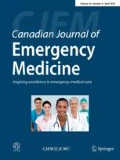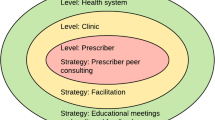Abstract
Objectives
Currently, there are no Canadian guidelines for discharge instruction to be given to patients receiving an opioid prescription in the ED. This likely contributes to inadequate discharge instructions for these potentially dangerous medications. The principal goal of this study was to develop an interdisciplinary Canadian consensus regarding important concepts to be included in written opioid discharge instructions within the ED setting.
Methods
We conducted a modified Delphi study between May and August 2021. The national multidisciplinary panel consisted of 23 healthcare professionals and one patient partner. The survey consisted of 19 initial concepts developed after a review of the literature and a meeting with local experts. The panel added four new concepts after the first survey round. Three rounds of online surveys were distributed in total. Panel consensus was defined a priori as a disagreement index score less than 1, in accordance with the RAND/UCLA Appropriateness Method.
Results
We achieved a 100% response rate in round one and a 96% response rate in rounds two and three of our Delphi study. There was group consensus (disagreement index = 0.66, median importance = 9) that all patients receiving opioid prescriptions from the ED should receive written discharge instructions. The interdisciplinary panel arrived at a consensus on 21/23 concepts for ED opioid discharge instructions. The concepts with the highest level of agreement were related to minimizing the use of the prescribed opioid medication and opioid use safety (mixing with drugs/alcohol, storage, and impairment).
Conclusion
This Delphi study with a national, multidisciplinary panel achieved consensus on 21 concepts that should be included in written discharge instructions to patients receiving an opioid prescription upon discharge from the ED.
Résumé
Objectifs
Actuellement, il n’y a pas de lignes directrices canadiennes sur les instructions de sortie à donner aux patients qui reçoivent une ordonnance d'opioïdes aux urgences. Cela contribue probablement à des instructions de sortie inadéquates pour ces médicaments potentiellement dangereux. L’objectif principal de cette étude était d’établir un consensus canadien interdisciplinaire sur les concepts importants à inclure dans les directives écrites de sortie des opioïdes dans le contexte des urgences.
Méthodes
Nous avons mené une étude Delphi modifiée entre mai et août 2021. Le comité national multidisciplinaire était composé de 23 professionnels de la santé et d’un patient partenaire. L’enquête comprenait 19 concepts initiaux développés après un examen de la littérature et une réunion avec des experts locaux. Le panel a ajouté quatre nouveaux concepts après la première ronde d’enquête. Trois séries de sondages en ligne ont été distribuées au total. Le consensus du panel a été défini a priori comme un indice de désaccord inférieur à 1, conformément à la méthode de pertinence RAND/UCLA.
Résultats
Nous avons atteint un taux de réponse de 100 % au premier tour et un taux de réponse de 96 % aux deuxième et troisième tours de notre étude Delphi. Il y avait un consensus de groupe (indice de désaccord = 0,66, importance médiane = 9) sur le fait que tous les patients recevant une ordonnance d'opioïdes aux urgences devraient recevoir des instructions écrites à la sortie de l'hôpital. Le groupe interdisciplinaire est parvenu à un consensus sur les concepts 21/23 pour les instructions de sortie d’opioïdes aux urgences. Les concepts ayant fait l’objet du plus haut niveau d’entente étaient liés à la réduction de l’utilisation des médicaments opioïdes prescrits et à la sécurité de l’utilisation des opioïdes (mélange avec les drogues/alcool, stockage et affaiblissement des facultés).
Conclusion
Cette étude Delphi avec un panel national multidisciplinaire a permis de parvenir à un consensus sur 21 concepts qui devraient être inclus dans les instructions écrites de sortie aux patients recevant une ordonnance d’opioïdes à leur sortie de l’urgence.

Similar content being viewed by others
References
Opioid-related harms in Canada - Public Health Infobase | Public Health Agency of Canada. https://health-infobase.canada.ca/substance-related-harms/opioids/
Imtiaz S, Rehm J. The impact of prescription opioids on all-cause mortality in Canada. Subst Abuse Treat Prev Policy. 2016;11(1):27. https://doi.org/10.1186/s13011-016-0071-4.
Mack KA, Jones CM, Paulozzi LJ. Vital signs: overdoses of prescription opioid pain relievers and other drugs among women—United States, 1999–2010. Morb Mortal Wkly Rep. 2013;62(26):537–42.
Barnett ML, Olenski AR, Jena AB. Opioid-prescribing patterns of emergency physicians and risk of long-term use. N Engl J Med. 2017;376(7):663–73.
Heard K, Ledbetter CM, Hoppe JA. Association of emergency department opioid administration with ongoing opioid use: a retrospective cohort study of patients with back pain. Acad Emerg Med. 2020;27(11):1158–65.
Ali MM, Cutler E, Mutter R, Henke RM, Mazer-Amirshahi M, Pines JM, et al. Opioid prescribing rates from the emergency department: down but not out. Drug Alcohol Depend. 2019. https://doi.org/10.1016/j.drugalcdep.2019.107636.
Pappa A. Prescribing and dispensing opioids in the emergency department. 2013. http://washingtonacep.org/Postings/edopioidabuseguidelinesfinal.pdf
Hastings SN, Barrett A, Weinberger M, Oddone EZ, Ragsdale L, Hocker M, et al. Older patients’ understanding of emergency department discharge information and its relationship with adverse outcomes. J Patient Saf. 2011;7(1):19–25. http://journals.lww.com/01209203-201103000-00004
CMPA. CMPA good practices guide—opioids. https://www.cmpa-acpm.ca/serve/docs/ela/goodpracticesguide/pages/manage_risk/Medication_risks/opioids-e.html
Mccarthy DM, Cameron KA, King JP, Mullen RJ, Bailey SC, Jacobson KL, et al. Patient recall of health care provider counseling for opioid-acetaminophen prescriptions. Pain Med (United States). 2014;15(10):1750–6. https://academic.oup.com/painmedicine/article-abstract/15/10/1750/1941263
Mccarthy DM, Wolf MS, Mcconnell R, Sears J, Chevrier A, Ahlstrom E, et al. Improving patient knowledge and safe use of opioids: a randomized controlled trial. Acad Emerg Med. 2015;22(3):331–9. www.aemj.org
Conrardy M, Lank P, Cameron KA, McConnell R, Chevrier A, Sears J, et al. Emergency department patient perspectives on the risk of addiction to prescription opioids. Pain Med. 2015. https://doi.org/10.1111/pme.12862.
Mccarthy DM, Engel KG, Cameron KA. Conversations about analgesics in the emergency department: a qualitative study. Patient Educ Couns. 2016;99(7):1130–7. https://doi.org/10.1016/j.pec.2016.01.011.
McCarthy DM, Cameron KA, Courtney DM, Adams JG, Engel KG. Communication about opioid versus nonopioid analgesics in the emergency department. J Opioid Manag. 2015;11(3):229–36 (Weston Medical Publishing).
Hall JN, Graham JP, McGowan M, Cheng AHY. Using written instructions to improve the quality of emergency department discharge communication: an interdisciplinary, patient-centered approach. Am J Med Qual. 2018;33(2):216–216. https://doi.org/10.1177/1062860618755250.
Borgundvaag B, McLeod S, Khuu W, Varner C, Tadrous M, Gomes T. Opioid prescribing and adverse events in opioid-naive patients treated by emergency physicians versus family physicians: a population-based cohort study. C Open. 2018;6(1):E110–7.
Online. Institute for Safe Medication Practices Canada REPORT MEDICATION INCIDENTS safer decisions save lives: key opioid prescribing messages for community practitioners. 2016. http://nationalpaincentre.mcmaster.ca/opioid/cgop_b_app_b08.html
Hsu C-C, Sandford BA. The Delphi technique: making sense of consensus. Pract Assess Res Eval. 2007;12:10.
Fitch K, Bernstein SJ, Aguilar MD, Burnand B, LaCalle JR, Lazaro P, et al. The RAND/UCLA appropriateness method user’s manual. RAND. Santa Monica: RAND; 2001.
Hasson F, Keeney S, McKenna H. Research guidelines for the Delphi survey technique. J Adv Nurs. 2000;32(4):1008–15.
Diamond IR, Grant RC, Feldman BM, Pencharz PB, Ling SC, Moore AM, et al. Defining consensus: a systematic review recommends methodologic criteria for reporting of Delphi studies. J Clin Epidemiol. 2014;67(4):401–9.
Boulkedid R, Abdoul H, Loustau M, Sibony O, Alberti C. Using and reporting the Delphi method for selecting healthcare quality indicators: a systematic review. PLoS ONE. 2011;6(6): e20476.
Curran JA, Murphy A, Burns E, Plint A, Taljaard M, Macphee S, et al. Essential content for discharge instructions in pediatric emergency care: a Delphi study. Pediatr Emerg Care. 2018;34(5):339–43.
Scott AR, Sanderson CJ, Rush AJ, Alore EA, Naik AD, Berger DH, et al. Constructing post-surgical discharge instructions through a Delphi consensus methodology. Patient Educ Couns. 2018;101(5):917–25.
Yadav K, Boucher V, Le Sage N, Malo C, Mercier É, Voyer P, et al. A Delphi study to identify prehospital and emergency department trauma care modifiers for older adults. Can J Surg. 2021;64(3):E339–E339. https://go-gale-com.proxy.bib.uottawa.ca/ps/i.do?p=AONE&sw=w&issn=0008428X&v=2.1&it=r&id=GALE%7CA667264834&sid=googleScholar&linkaccess=fulltext
Donaldson IA, Alonzi R, Barratt D, Barret E, Berge V, Bott S, et al. Focal therapy: patients, interventions, and outcomes-a report from a consensus meeting. Eur Urol. 2015;67(4):771–7. https://doi.org/10.1016/j.eururo.2014.09.018.
Dribin TE, Sampson HA, Camargo CA, Brousseau DC, Spergel JM, Neuman MI, et al. Persistent, refractory, and biphasic anaphylaxis: a multidisciplinary Delphi study. J Allergy Clin Immunol. 2020;146(5):1089–96.
Taylor WJ, Schumacher HR, Baraf HSB, Chapman P, Stamp L, Doherty M, et al. A modified Delphi exercise to determine the extent of consensus with OMERACT outcome domains for studies of acute and chronic gout. Ann Rheum Dis. 2008;67(6):888–91.
Maverakis E, Ma C, Shinkai K, Fiorentino D, Callen JP, Wollina U, et al. Diagnostic criteria of ulcerative pyoderma gangrenosum: a delphi consensus of international experts. JAMA Dermatol. 2018;154(4):461–466. https://jamanetwork-com.proxy.bib.uottawa.ca/journals/jamadermatology/fullarticle/2672268
Sohn M, Brinkman R, Wellman GS. Coprescription of opioid and naloxone in office-based practice and emergency department settings in the United States. Public Health. 2020;1(180):82–4.
Dwyer K, Walley AY, Langlois BK, Mitchell PM, Nelson KP, Cromwell J, et al. Opioid education and nasal naloxone rescue kits in the emergency department. West J Emerg Med. 2015;16(3):381.
Chakravarthy B, Somasundaram S, Mogi J, Burns R, Hoonpongsimanont W, Wiechmann W, et al. Substance Abuse Randomized pilot trial measuring knowledge acquisition of opioid education in emergency department patients using a novel media platform Randomized pilot trial measuring knowledge acquisition of opioid education in emergency department pat. Subst Abus. 2017;39(1):547-0164. https://www.tandfonline.com/action/journalInformation?journalCode=wsub20
Koh JJ, Klaiman M, Miles I, Cook J, Kumar T, Sheikh H, et al. CAEP Position Statement: emergency department management of people with opioid use disorder. Can J Emerg Med. 2020;22(6):768–71. Available from: https://www-cambridge-org.proxy.bib.uottawa.ca/core/journals/canadian-journal-of-emergency-medicine/article/caep-position-statement-emergency-department-management-of-people-with-opioid-use-disorder/C6D0152F523A311D21E6C7251FF1DD55
Acknowledgements
We thank Angela Marcantonio for her assistance with this project. Karine Fournier was invaluable to completing the literature review. We would also like to thank the panellists who completed the Delphi Survey, especially our patient partners.
Funding
This project received no funding.
Author information
Authors and Affiliations
Contributions
NMM, KY, RD and DE conceived the idea, were responsible for study design, survey development, data collection and analysis. DJ, AN, RH, and MZ were also responsible for survey development. All authors contributed to the interpretation of study results and the completion of the manuscript. NMM takes responsibility for the project as a whole.
Corresponding author
Ethics declarations
Conflict of interest
The authors have no conflicts of interest to declare.
Supplementary Information
Below is the link to the electronic supplementary material.
Rights and permissions
Springer Nature or its licensor holds exclusive rights to this article under a publishing agreement with the author(s) or other rightsholder(s); author self-archiving of the accepted manuscript version of this article is solely governed by the terms of such publishing agreement and applicable law.
About this article
Cite this article
Murray, N.M., Yadav, K., Daoust, R. et al. Emergency department opioid discharge instructions: a multidisciplinary national Delphi study. Can J Emerg Med 24, 641–649 (2022). https://doi.org/10.1007/s43678-022-00352-7
Received:
Accepted:
Published:
Issue Date:
DOI: https://doi.org/10.1007/s43678-022-00352-7




